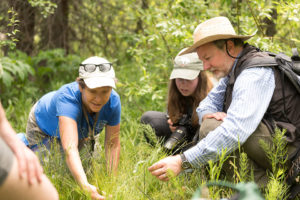
It’s been 10 years in the making and has involved collaborative efforts between multiple partners and state agencies. On Nov. 1, CODEX — Colorado’s Conservation Data Explorer — will be unveiled for use by the general public.
Led by the Colorado Natural Heritage Program at Colorado State University with support from Colorado Parks and Wildlife, CODEX is a web-based interactive map viewer with tools to support conservation planning, return on investment of conservation dollars, evaluation of projects, teaching, research and education.
CODEX allows users to develop project maps and run queries, saving them securely in a personal portfolio, with an option to submit them for review to stakeholders. Users will access key, quality data in one place for the first time ever, said David Anderson, one of the project’s leaders and chief scientist at the Colorado Natural Heritage Program, part of the Warner College of Natural Resources at CSU.
“Increasing access to comprehensive data will allow for a common understanding of which resources of concern exist in the user’s area of interest,” said Matt Schulz, project lead for Colorado Parks and Wildlife. “CODEX provides a great complement to the local knowledge of our field staff and our ability to communicate wildlife habitat considerations, which is especially valuable in the early stages of project development.”
View, sign up to use CODEX
Create a new account on the CODEX site: https://col.st/k2jk7
Users can submit project areas for review, obtain comprehensive conservation planning information, make maps, and run analyses.
CODEX provides conservation information on biological diversity, protected lands, hydrology and other natural resources for planning purposes. Users can also screen a project area for potential impacts to threatened and endangered species and their habitats.

Colorado is the 11th state to launch this user-friendly tool, with the ultimate aim being to enhance the flow of decision quality data from CSU and partners to the people of Colorado, advancing efforts to encourage decisions on land use to consider the state’s natural heritage.
CSU President Joyce McConnell said that CODEX fits perfectly with the University’s land-grant mission and with CSU’s Courageous, Strategic Transformation that aims to foster “a sustainable, thriving planet.”
“It’s rewarding to see this project come to fruition after many years of hard work by CSU scientists and our partners,” McConnell said. “We are thrilled to join other states in providing a resource for people to use in Colorado and beyond our borders.”
CODEX will solve many challenging problems for planning conservation projects in the state. Prior to the launch of the tool, people working in development, management and conservation had to go to many different sources to find the data they need to make decisions.
CODEX puts key information in one place
“The tool is unique because it is the culmination of a broad partnership that brings together all kinds of data from Colorado Parks and Wildlife, land trusts, The Nature Conservancy, Bird Conservancy of the Rockies, cultural data, data on noxious weeds and other sources,” Anderson said.
One unusual aspect of CODEX — when compared with similar tools in other states — is that it provides an estimate on the return on investment of conservation dollars for a given property.
The Colorado Natural Heritage Program worked with Professor Andy Seidl in CSU’s Department of Agricultural & Resource Economics to assess the return on investments in conservation easements in Colorado. The team found that every dollar invested yields a $4 to $12 return.
How to use CODEX
Anderson said that people can use CODEX to draw an area they’re interested in on a map, and the tool will give them a detailed report about that particular piece of land.
CODEX provides a comprehensive list of resources on and near the property or area of interest, giving the user an estimate of the ecosystem services or nature’s benefits in the area.
The nonprofit NatureServe developed the technology that runs CODEX and similar tools in other states. Explore a story map of CODEX created by NatureServe: https://col.st/1dkXe
Students, others already using CODEX
Anderson said that state agencies and other organizations are already poised to use the new tool.
In late October 2020, Gov. Jared Polis signed an executive order creating the Colorado Outdoor Regional Partnerships Initiative to ensure that the state remains a world-class outdoor destination while preserving land, water, wildlife and quality of life.
To carry out this initiative, the state will support the use of CODEX by regional partnerships as they create plans for recreation and conservation.
CSU faculty will also be able to use CODEX for teaching and research purposes.